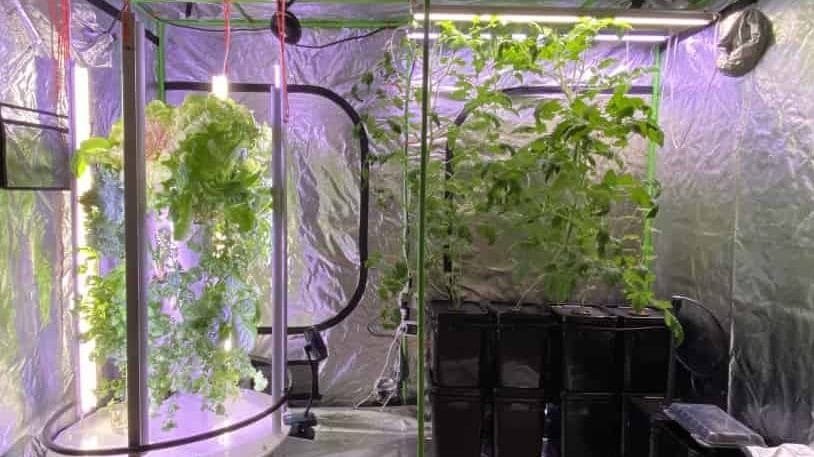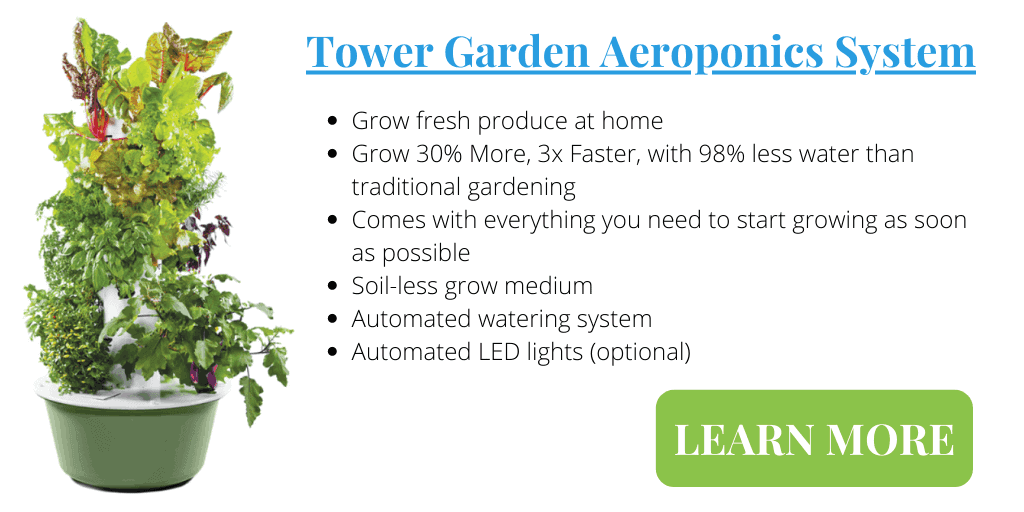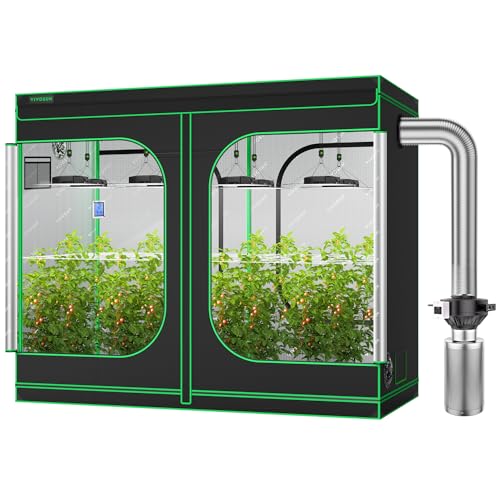Grow tents are very popular with indoor growers because they allow total control over the growing conditions without affecting the comfort inside your home. These small indoor grow spaces can give you an all year round garden in your home or just let you get an early start on sprouting your outdoor crops.
A grow tent is not a greenhouse because it does not use the sun’s light and energy in the growth of your plants. Instead a grow tent is used indoors with artificial grow lights, exhaust fans and other equipment to provide the best conditions to grow plants indoors.
Let’s explore the differences between a grow tent and a greenhouse, as well as the advantages and disadvantages of both in more detail.

Using A Grow Tent For Gardening
A grow tent is technically a greenhouse, but they are intended for indoor use and should not be used outdoors as a regular greenhouse as this can damage the grow tent’s structure. This will also decrease the lifespan of your tent.
More people are starting to grow their own food to ensure their fruits and vegetables are as organic as possible and help save some money. People living in northern climates are opting for grow tents inside their homes and garages to create a perfect indoor growing space.
Many people wonder if they need a grow tent to garden inside. Learn the answer to this question in my article, Do You Need A Tent To Grow Indoors?
Grow tents are small, enclosed areas generally made from a lightweight fabric with a reflective interior. Mounted on a metal frame, these growing cubes are designed to have hanging lights and an exhaust fan to circulate fresh air into the tent.
Grow tents are mainly used by micro-gardeners who wish to maintain a very high level of control over their plants’ environment. This means you can successfully grow a wide variety of plants in a small indoor space.
- Keeps All Light Inside: The VIVOSUN Hydroponic Mylar Grow Tent is made of high-quality 600D...
- Low Costs & High Efficiency: VIVOSUN VS4000 LED grow light uses Samsung LM301 diodes & brand...
- Powerful Air Flow: Heavy-hitting blower with a fan speed of 2450 RPM; Puts out only 50 dB noise...
The Differences Between A Greenhouse And A Grow Tent
Location of Use
The main differences between greenhouses and grow tents is the location in which they’re used. As transparent structures, greenhouses are used outdoors to harness the natural light and energy of the sun for growing plants. A grow tent is not designed for use outdoors and does not function without artificial lighting inside.
My recent article explains why you need a grow tent to grow indoors
Size of Structure
Greenhouses are often much bigger than grow tents, as a grow tent is meant to be kept indoors, while a greenhouse is used outdoors. This usually means that you can keep more plants in a greenhouse than a grow tent since there is more space.
Material of Construction
The material that these two grow houses are made from is also vastly different. Greenhouses are made from two different materials, depending on whether it’s meant to be a permanent setup or if it’s meant to be temporary.
If you want a permanent greenhouse, it is generally made from tempered glass panels. If your greenhouse is going to be temporary, then it will usually be made of some clear plastic poly wrapped over a metal frame.
Grow tents are typically made of an insulated woven nylon material lined with mylar on the interior. The heavy duty tent is supported by a metal or plastic frame to create a box shape with windows, vents and large zippered doors for easy access.
Grow tents also have a reinforced floor or second floor pan to protect the interior floors of your home from water damage and spills. Greenhouses on the other hand typically have a dirt floor for direct planting or placed in parking lots as garden centers.
Find out more about grow tent construction in my recent article: Can Grow Tents Catch Fire
Pros And Cons of Grow Tents
Grow tents have some disadvantages and advantages that you should be aware of before you buy one. Some of these benefits may outweigh the disadvantages for some people, but the disadvantages can be a big deal for others. Let’s go through them so you can decide which side you fall into.
Advantages of Grow Tents
Grow tents have some unique benefits on offer that you will not get from a greenhouse. One of these benefits is a higher level of control of the environment inside the grow tent.
Better Climate Control
The equipment you have with a grow tent, and the fact that it is kept indoors allows you to control the temperature and humidity levels more easily inside the tent. This means you can ensure your plants are kept in the best growing conditions.
Find out where to place a dehumidifier a grow tent
Extended Growing Season
Grow tents can also be used to grow certain vegetables out of season as you have a lot of control of the internal environment of the tent. If you keep certain vegetables in the perfect environment in the grow tent like green beans or peas, you may notice a higher crop yield.
Efficient Energy Footprint
A grow tent can save you money in the long run, as it is easier and cheaper to control the environment of one small area than it is an entire room-sized space like a traditional greenhouse.
Grow tents often have reflective material on the interior walls known as mylar. This mylar finish means that all the plants in your grow tent receive high-quality light from all angles, so no plant receives less light than another in the grow tent.
This boosts the photosynthesis of the plants that you keep in your grow tent, helping them grow stronger, stay healthy, and happy, and it also makes the grow tent pretty energy efficient.
Fewer Pest Problems
Using a grow tent does also help prevent pest infestations on your plants as they are kept indoors, in a sealed space that is climate controlled. This means that pests will have difficulty penetrating the area and attacking your plants.
I grow herbs, veggies and strawberries all year round in my home office using a 4×8 grow tent and my Tower Garden vertical aeroponic growing system. The Tower Garden can grow 20+ plants in a corner of my tent providing my family with fresh and nutritious salad greens, tomatoes and herbs.
Since the tower is is operated by automatic timers I never worry about turning on the lights or watering the plants. I share everything I’ve learned about growing with a tower garden in this article.

Disadvantages of Grow Tents
Even though the grow tent has some nice benefits, there are some disadvantages that you should know about before you go and buy one for yourself. Also, check out my article, Is A Grow Tent A Good Investment?
Low Margin For Error
One of the disadvantages of a grow tent is that your plants in the grow tent are planted in pots and not the soil in your garden like they would be in a greenhouse. This means that you will need to keep a closer eye on your plants and monitor that they are getting the water and nutrients they need to survive.
Depending on the plants you have, you will need to fertilize your plants regularly, with well-balanced fertilizers to ensure your plants have everything they need to grow properly.
If you get the balance wrong in the fertilizer or do not fertilize your plants, your plants could have stunted growth and a lower crop yield. If you leave them without nutrients for an extended period, then your plants will die. They are not as self-sufficient as plants that are kept in a greenhouse.
More Technology intensive
With a grow tent, you will need some equipment to maintain and monitor the environment inside the tent to match the growing conditions to the needs of your plants.
You will need full spectrum grow lights, circulation fans, and exhaust fans and possibly humidity and temperature control equipment. All this equipment can be expensive, and you will need all of it to run your grow tent effectively, so you will need to buy it all at once. This can take a toll on your finances.
For safety reasons I’ve created an article to address whether or not some grow lights are a fire hazard
Pros And Cons of Greenhouses
Greenhouses have some disadvantages and advantages that you should know before you buy and install one in your garden. Some of these benefits may outweigh the disadvantages for some people, but the disadvantages can be a big deal for others. Let’s go through them so you can decide which side you fall into.
Advantages of Greenhouses
Greenhouses also have some unique benefits on offer that you will not get from a grow tent. Greenhouses are outdoor structures which can be as small as a closet or bigger than a house.
Extending Growing Seasons with Greenhouses
Green houses create longer growing seasons similar to grow tents but are still limited by outdoor conditions. Greenhouses can store and distribute warmth inside the structure while the outdoor temperatures drop below the natural limits of your plants.
This also means that greenhouses allow you to grow more plants and a wider variety of plants inside them. You can also grow plants that require more space to grow, like watermelon and sweet potatoes.
Direct Soil Planting
When you use a greenhouse, you can plant your plants straight into the ground inside the greenhouse, eliminating the need for planters.
Planting straight into the ground can also lower the need for fertilizing your plants as they will have access to more nutrients as they are in the ground, lowering your plant care costs.
Low Energy Dependency
With a greenhouse, you will need less equipment to keep it running than you would a grow tent. You will still need a heater for the colder months and a circulation fan or two, but that’s about it. When you have a greenhouse running correctly, you can have plants growing happily in them all year.
Disadvantages of Greenhouses
Even though greenhouses have some nice benefits, there are some disadvantages that you need to know about before you decide that this is for you and go and buy one for yourself.
Greenhouses can take up a large amount of space in your garden, which some people do not have. You can look at different sizes, but they are all generally quite large and can be tricky to fit into certain gardens.
You will need to connect your greenhouse to electricity to keep the fans running and the heaters going in the winter. This can require a lot of time and effort to accomplish, and it can be expensive if you get a professional to help you.
Plants grown in a greenhouse are more prone to pest infestations than those grown in a grow tent. This is because the plants are still exposed to the outside world when you open the greenhouse, and insects can get to the plants through the soil.
Depending on where you place your greenhouse, it can become an eye sore as they are not all pretty to look at.
Which One Is Better For Growing Vegetables?
Both a greenhouse and a grow tent are viable options to grow vegetables in, and you can be quite successful with either. There is no “one is better than the other” scenario here, as they are both useful and great methods of growing your vegetables.
If your region has 5-6 months of outdoor growing climate and you have an outdoor space, than using a greenhouse may be your best option for growing.
If you prefer to grow indoors, live in a climate with a short growing season or have limited outdoor space then a grow tent will provide the space you need for indoor growing.
Many people that decide on using an outdoor greenhouse for growing also grow indoors during the colder months using a grow tent. A grow tent is helpful for keeping potted tropical and perennial plants alive when the outdoor climate is too cold.
A grow tent can also help you get an early start to your outdoor growing season by starting your seeds, herbs, fruits and veggies earlier in the season.
Tips For Using A Grow Tent
If you are going to buy yourself a grow tent, then there are a few useful tips that you must know before you get started to ensure that you are as successful as possible growing your plants in a grow tent.
- Ensure you buy all the equipment needed before you plant anything in your grow tent.
- identify the growing conditions needed for the plants you wish to grow and ensure you create that environment inside the grow tent before you plant the plants.
- Build or buy shelves that will fit inside your grow tent as this will help you fit more plants inside it.
- Buy a thermometer that can stay inside the grow tent, so you can easily monitor the conditions inside the tent.
Tips For Using A Greenhouse
If you are going to buy yourself a greenhouse, then there are a few useful tips that you should know before getting started to ensure that you are as successful as possible in growing your plants in a greenhouse. So, here are a few helpful tips:
- Plan the layout of your greenhouse before you start planting; this will ensure you have enough space for everything you want to grow and make it easier to keep track of where you planted what.
- Fertilize your soil before you plant anything in the ground, as this will give you a few months without needing to worry about fertilizer once your plants are in.
Conclusion
Greenhouses and grow tents are designed for growing in different locations. Both help control the environment where you grow your plants however grow tents are used indoors while greenhouses are used outdoors. They can be used separately or in conjunction to create a year round growing experience.

